(Strand)om Stories: Punisher: Circle of Blood Review
This action thriller exchanges nuance for fun as the Punisher is distilled to his core characteristics
—by Nathan on May 1, 2025—
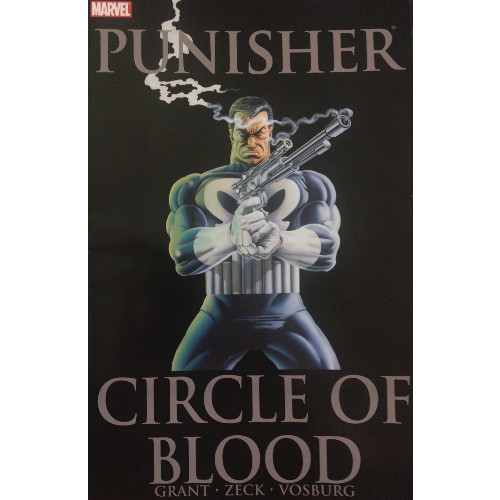
In one of my early "Spider-view" posts, I reviewed a two-part Spectacular Spider-Man narrative which saw Spidey come into conflict with the Kingpin, Cloak and Dagger (who try to take down the Kingpin), and the Punisher (who tries to mow down the Kingpin). The second issue opened with a bizarre scene where the Punisher takes potshots at "criminals" of all shades, from a couple involved in a domestic squabble to a man who litters. Cause dropping a wad of trash on the concrete is just the start of a very slippery slope, friends, and if you do that, it's just best that Frank Castle puts you down now.
I critiqued the scene, blaming writer Bill Mantlo for leaning far too heavily into the Punisher's "armed vigilante" shtick, not really grasping the nuance of the character. Just cause the guy has a gun and a hatred for crime doesn't mean he's going to blow away every litterbug and jaywalker in New York. This application of the Punisher's punishment felt illogical…and it seems Steven Grant may have agreed.
In the early 90s, Grant wrote a two-issue Amazing Spider-Man arc I recently reviewed, focused on a couple of costumed doctors who apparently took the hippo-critic oath, doing a good deal of harm to folks who seemingly deserved it but most likely didn't. Reading that arc, I recalled Grant also wrote the first-ever solo Punisher book, a five-issue limited series illustrated by Mike Zeck of "Kraven's Last Hunt" and Marvel Super Hero Secret Wars fame. In this series' first issue, Frank Castle claims he was drugged while at Ryker's Penitentiary, explaining his crazy antics. But now? Now, Castle's mind is clear, and he's gonna find whoever twisted his brain and make them pay…
…along with a whole buncha other greaseballs.
Punisher: Circle of Blood
Writers: Steven Grant and Jo Duffy
Pencilers: Mike Zeck and Mike Vosburg
Inker: John Beatty
Colorists: Mike Zeck and Bob Sharen
Letterers: Ken Bruzenak
Issues Collected: The Punisher #1-5
Volume Publication Date: January 2011
Issue Publication Dates: January 1986-May 1986
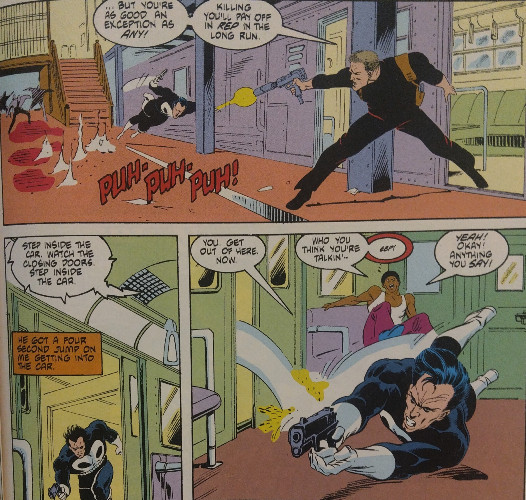
Let's clear some confusion out of the way: this is a five-issue limited series. Though promoted through a banner at the top of its first issue's cover as a four-issue limited series, The Punisher ran for five issues, despite the fact other covers carried the errant number count. But though Marvel missed with this counting error, the Punisher finds he rarely does.
If you like bullets blasting bad guys, you'll find a lot to appreciate about this series, because that's what Frank Castle does in spades. And not just bullets! He hurts people with glass, sticks, his fists…heck, he even kills one guy with a subway train door, though as politely as you can kill somebody with a subway train door in a mid-80s comic.
The series balances on a precipice the whole way through. It wants to offer violence and action on nearly every page–guns! explosions! death!–and it does, but it finds itself somewhat curtailed by the common courtesies of the era. The result is a series that pushes the boundaries just enough, walking a fine line between "adults only" material and presenting a story appropriate for readers slightly older than prepubescents. I found Grant and Zeck (with Jo Duffy and Mike Vosburg for the final issue) nailed the tone in the first few issues, reminding us solidly of the Punisher's grittier roots through frantic prison sequences and a gang war The Godfather fans would appreciate. You hear people call Batman's mission a "one man war on crime," but Grant and Zeck prove how much more apt that phrase applies to Frank Castle's crusade.
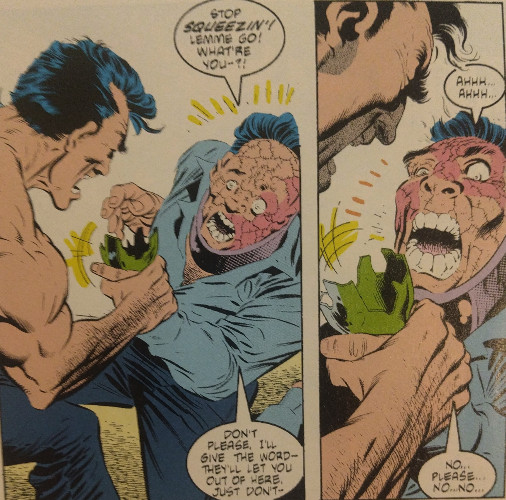
Because what distinguishes Batman from the Punisher is Castle's end goal: the eradication of criminal activity…through the eradication of criminals. As such, Grant and Zeck craft a character who sticks to that single-minded goal of destruction. Now, I like my morally frustrated characters, I like guys who mull over the consequences of their actions or wonder about how far they're willing to go. Through the argument has become old hat, the whole Spidey/Punisher debate (or even the Daredevil/Punisher debate) over the Vietnam veteran's gunslinging has its merits in its basic definition: it's not good over evil, it's good over what's transformed into an alternate definition of "good," and in an era where America faced questions over self-defense and vigilantism as indicated by events such as the Bernhard Goetz subway slayings, that definition certainly needed refining. Where do vigilantism and heroism cross over in their definitions of defending others, and where do they diverge?
But this series largely scraps that internal conflict, and I feel that works. This is a Punisher comic. Spidey doesn't show up to deliver a tongue-wagging, nor does Daredevil pop in to berate Castle. The story is narrated from the Punisher's perspective; therefore, we're playing by the Punisher's rules. Castle's methods are a given, and Grant and Zeck play it as absolutely straight as they can, which works with the story's strengths. Readers are left to determine the validity of Castle's actions on their own–what side do you fall on?
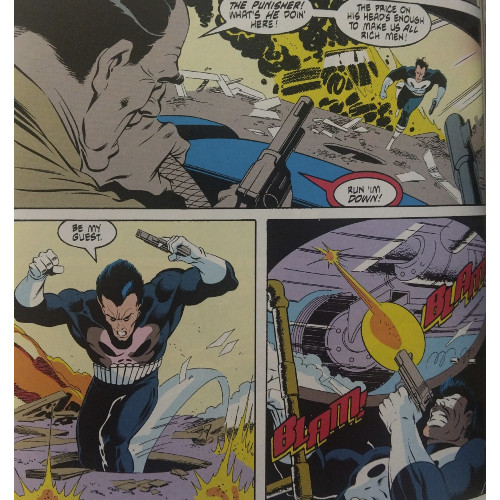
Frank does take responsibility for certain actions– such as promoting a gang war throughout New York–when innocent people are hurt and even killed, but even this comes with caveats. He's less concerned with having promoted the war in the first place and feels guiltier about losing control of the war. It's not the escalating violence itself which is ever the issue, just his inability to keep it moving in the direction he wants it to. Death and bloodshed are completely fine as long as the right people receive a bullet between the eyes…and when Castle reaches a point where he feels maybe he's in a little over his head, his plan involves (guess what?) redirecting that violence. This internal turmoil tethers into the collected edition's title and primary image–the "circle of blood" Castle pictures around the city, pulling in everyone around the violence. Violence begets violence, it's inevitable. The Punisher only wishes to cut it off at the source, believing (perhaps, it's implied, somewhat misguidedly) he can kill the killers and cull the mob warfare.
Grant and Zeck leave the series after four issues, and though Grant supplies the story for the fifth issue, the replacement team of Duffy and Vosburg fail to bring the same energy and grounded feel to the final issue. Grant and Zeck have developed a taut thriller up to this point, fleshing out a dramatic prison escape and brutal gang war, largely avoiding any kind of silly or campy elements. A bit of goofiness exists–several hired killers run around dressed as the Punisher, and Frank ends the fourth issue in a gimmicky deathtrap–but they've maintained a steady tone. Duffy and Vosburg don't necessarily change it up, but they don't work with the same smoothness existing between Grant and Zeck. You feel as if they recognize they're the pinch hitters (I am by no means a sports guy, so apologies if I am using that term incorrectly), asked to wrap up someone else's story. So they finish all the necessary plot points–your main bad guys get their big comeuppance, a subplot Grant created is finished–but without any vigor. Things just happen, Frank saves the day. It's all neat and tidy. The work here is done, folks. Come again tomorrow.
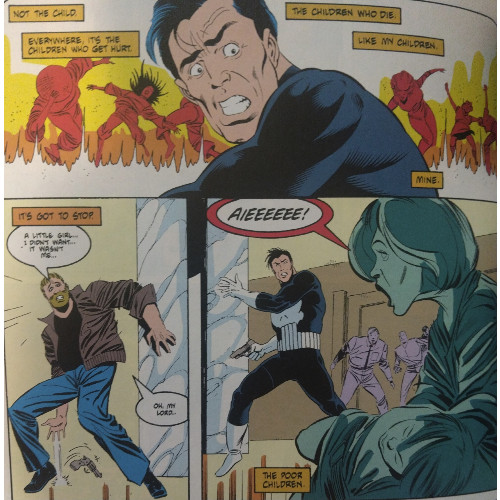
The ending is lackluster, but the rest of the series reads fairly well. Grant and Zeck distill the Punisher down to his core principles: he's a violent guy in a violent world and so reacts to violence with violence. And not against jaywalkers and litterbugs but big bozos who genuinely deserve it, at least according to the gospel of Frank Castle. I often prefer nuance and subtlety to in-your-face rudeness. But Frank Castle's an in-your-face kinda guy, and he's a cave-in-your-face kinda guy too. This is unashamedly a blockbuster action thriller, a revenge story with a billowing body count, hopped up on all the fun that can come with a lone man with a gun (and glass and sticks and subway train doors) against the New York underworld.